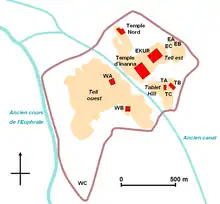The Shatt en-Nil Is a dry river bed/canal in southern Iraq.[1] It is also known as the Naru Kabari.[2][3][4]

Map of the Shatt en-Nil through Nippur
Called the Euphrates of Nippur, the river was an important irrigation[5] and transport infrastructure for the city of Nippur during antiquity. The canal started just north of Babylon and travelled for 60 km[6] ending at Larsa where it rejoined the Euphrates River. On the way it flowed through Nippur (32.55°N 44.42°E 34m). The canal also serviced the city of Tel Abib and Uruk.[7]
The canal is referred to in the so-called Murashu documents discovered at Nippur.[8] which record business transaction in the area around Nippur.The river/canal has also been one of the rivers identified as the biblical River Chebar.(כְּבָר [נְהַר)[9]
References
- ↑ James E. Smith, Ezekiel: A Christian Interpretation (Lulu.com, 2008)page 42.
- ↑ John L. Mckenzie, The Dictionary Of The Bible (Simon and Schuster, 1 Oct 1995) page 128.
- ↑ E. A. Wallis Budge, A History of Egypt from the End of the Neolithic Period to the Death of Cleopatra VII B.C. 30 (Routledge Revivals): Vol. VII: Egypt Under the Saites, Persians and Ptolemies (Routledge, 2013) page 11.
- ↑ Ezekiel’s Seventy Years.
- ↑ Hermann Vollrat Hilprecht, The Excavations in Assyria and Babylonia Cambridge University Press, 2011) page 413.
- ↑ Carl G. Rasmussen, Zondervan Atlas of the Bible (Zondervan, 30 Sep 2014) page.
- ↑ H.V. Hilprecht, Exploration in Bible Lands (1903)
- ↑ A.T. Clay, Business Documents of Murash – Sons of Nippur (1898)
- ↑ Leonard W. King, A history of Sumer and Akkad (Рипол Классик, 1994) page 9.
 Map of Iraq showing Shatt en-Nil
Map of Iraq showing Shatt en-Nil
This article is issued from Wikipedia. The text is licensed under Creative Commons - Attribution - Sharealike. Additional terms may apply for the media files.